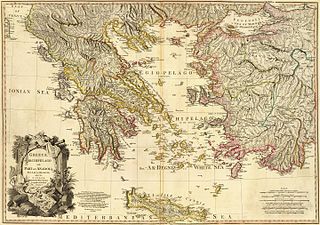 W
WThe history of the Eastern Roman Empire (324–1453) is generally considered to fall into three distinct eras:
 W
WThis history of the Byzantine Empire covers the history of the Eastern Roman Empire from late antiquity until the Fall of Constantinople in 1453 AD. Several events from the 4th to 6th centuries mark the transitional period during which the Roman Empire's east and west divided. In 285, the emperor Diocletian partitioned the Roman Empire's administration into eastern and western halves. Between 324 and 330, Constantine I transferred the main capital from Rome to Byzantium, later known as Constantinople and Nova Roma. Under Theodosius I, Christianity became the Empire's official state religion and others such as Roman polytheism were proscribed. And finally, under the reign of Heraclius, the Empire's military and administration were restructured and adopted Greek for official use instead of Latin. Thus, although it continued the Roman state and maintained Roman state traditions, modern historians distinguish Byzantium from ancient Rome insofar as it was oriented towards Greek rather than Latin culture, and characterised by Orthodox Christianity rather than Roman polytheism.
 W
WThe Abbasid invasion of Asia Minor in 782 was one of the largest operations launched by the Abbasid Caliphate against the Byzantine Empire. The invasion was launched as a display of Abbasid military might in the aftermath of a series of Byzantine successes. Commanded by the Abbasid heir-apparent, the future Harun al-Rashid, the Abbasid army reached as far as Chrysopolis, across the Bosporus from the Byzantine capital, Constantinople, while secondary forces raided western Asia Minor and defeated the Byzantine forces there. As Harun did not intend to assault Constantinople and lacked ships to do so, he turned back.
 W
WThe Abbasid invasion of Asia Minor in 806 was the largest of a long series of military operations launched by the Abbasid Caliphate against the Byzantine Empire. The expedition took place in southeastern and central Asia Minor, where the Abbasid and Byzantine empires shared a long land border.
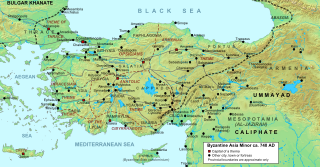 W
WThe Anatolic Theme, more properly known as the Theme of the Anatolics, was a Byzantine theme in central Asia Minor. From its establishment, it was the largest and senior-most of the themes, and its military governors (stratēgoi) were powerful individuals, several of them rising to the imperial throne or launching failed rebellions to capture it. The theme and its army played an important role in the Arab–Byzantine wars of the 7th–10th centuries, after which it enjoyed a period of relative peace that lasted until its conquest by the Seljuk Turks in the late 1070s.
 W
WThe Armeniac Theme, more properly the Theme of the Armeniacs was a Byzantine theme located in northeastern Asia Minor.
 W
WIn the 9th century, during the Arab–Byzantine wars, the Byzantine Empire used a system of beacons to transmit messages from the border with the Abbasid Caliphate across Asia Minor to the Byzantine capital, Constantinople.
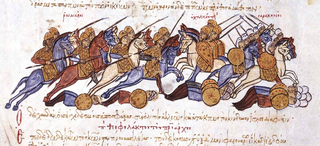 W
WThe Byzantine reconquest of Cilicia was a series of conflicts and engagements between the forces of the Byzantine Empire under Nikephoros II Phokas and the Hamdanid ruler of Aleppo, Sayf al-Dawla, over control of the region of Cilicia in southeastern Anatolia. Since the Muslim conquests of the 7th century, Cilicia had been a frontier province of the Muslim world and a base for regular raids against the Byzantine provinces in Anatolia. By the middle of the 10th century, the fragmentation of the Abbasid Caliphate and the strengthening of Byzantium under the Macedonian dynasty allowed the Byzantines to gradually take the offensive. Under the soldier-emperor Nikephoros II Phokas, with the help of the general and future emperor John I Tzimiskes, the Byzantines overcame the resistance of Sayf al-Dawla, who had taken control of the former Abbasid borderlands in northern Syria, and launched a series of aggressive campaigns that in 964–965 recaptured Cilicia. The successful conquest opened the way for the recovery of Cyprus and Antioch over the next few years, and the eclipse of the Hamdanids as an independent power in the region.
 W
WByzantine Iconoclasm refers to two periods in the history of the Byzantine Empire when the use of religious images or icons was opposed by religious and imperial authorities within the Orthodox Church and the temporal imperial hierarchy. The First Iconoclasm, as it is sometimes called, existed between about 726 and 787. The Second Iconoclasm was between 814 and 842. According to the traditional view, Byzantine Iconoclasm was started by a ban on religious images by Emperor Leo III and continued under his successors. It was accompanied by widespread destruction of images and persecution of supporters of the veneration of images. The pope remained firmly in support of the use of images throughout the period, and the whole episode widened the growing divergence between the Byzantine and Carolingian traditions in what was still a unified church, as well as facilitating the reduction or removal of Byzantine political control over parts of Italy.
 W
WThe Byzantine–Sasanian War of 602–628 was the final and most devastating of the series of wars fought between the Byzantine Empire and the Sasanian Empire of Iran. The previous war between the two powers had ended in 591 after Emperor Maurice helped the Sasanian king Khosrow II regain his throne. In 602 Maurice was murdered by his political rival Phocas. Khosrow proceeded to declare war, ostensibly to avenge the death of the deposed emperor Maurice. This became a decades-long conflict, the longest war in the series, and was fought throughout the Middle East: in Egypt, the Levant, Mesopotamia, the Caucasus, Anatolia, Armenia, the Aegean Sea and before the walls of Constantinople itself.
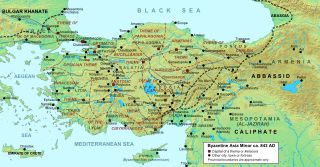 W
WChaldia was a historical region located in mountainous interior of the eastern Black Sea, northeast Anatolia. Its name was derived from a people called the Chaldoi that inhabited the region in antiquity. Chaldia was used throughout the Byzantine period and was established as a formal theme, known as the Theme of Chaldia, by 840. During the Late Middle Ages, it formed the core of the Empire of Trebizond until its fall to the Ottoman Empire in 1461.
 W
WThe Cibyrrhaeot Theme, more properly the Theme of the Cibyrrhaeots, was a Byzantine theme encompassing the southern coast of Asia Minor from the early 8th to the late 12th centuries. As the Byzantine Empire's first and most important naval theme, it served chiefly to provide ships and troops for the Byzantine navy.
 W
WKastamonu Castle is a medieval castle in Kastamonu, Turkey.
 W
WKızkalesi is a castle situated on a small island in Mersin Province of Turkey.
 W
WLykandos or Lycandus was the name of a Byzantine fortress and military-civilian province, known as the Theme of Lykandos, in the 10th–11th centuries.
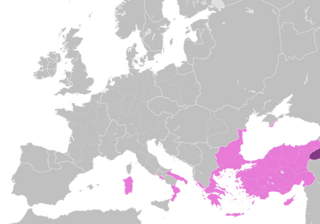 W
WMesopotamia was the name of a Byzantine theme located in what is today eastern Turkey. It should not be confused with the region of Mesopotamia or with the older Roman and early Byzantine province of Mesopotamia. The Byzantine theme was located between the rivers Arsanias and Çimisgezek.
 W
WKemalpaşa is a large town and the center of the district of the same name in İzmir Province, Turkey. Its district area extends immediately to the east of İzmir's easternmost metropolitan district, Bornova, and Kemalpaşa town being at a distance of only 29 km (18 mi) from the historical and traditional center of İzmir, (Konak), it pulsates along with the rhythm of the big city, with corresponding high levels of development in terms of industry and services. İzmir-Ankara highway crosses the district area 8 km (5.0 mi) to the north of the district center. Kemalpaşa district area borders on the administrative divisions of Manisa center in the north, Manisa's depending district of Turgutlu in the east and İzmir's depending districts of Torbalı and Bayındır in the south. The eastern and southern parts of Kemalpaşa district preserve their markedly rural characteristics, which results in an urbanization rate of only 25.7 for the district area as a whole, despite the presence of a strong industrial base in and to the west of Kemalpaşa town. Kemalpaşa's very large organized industrial zone (KOSBİ) brings together producers of construction materials, rubber and plastic goods, textiles and clothing, leather, paper, packaging materials, machinery and other equipment, including electrical tools and installations, dyes and other chemical substances, marble and car parts, as well as foundries and other metalworks. Agriculture also occupies a portion with high added value in Kemalpaşa's economy, its cherries being of nationwide renown and exported. Literacy is at a high level at 90%, and the neighboring Bornova, where Ege University is based, serves as a nearby pool in terms of trained personnel.
 W
WPaphlagonia was an ancient region on the Black Sea coast of north central Anatolia, situated between Bithynia to the west and Pontus to the east, and separated from Phrygia by a prolongation to the east of the Bithynian Olympus. According to Strabo, the river Parthenius formed the western limit of the region, and it was bounded on the east by the Halys river. The name Paphlagonia is derived in the legends from Paphlagon, a son of Phineus.
 W
WSagalassos, also known as Selgessos and Sagallesos, is an archaeological site in southwestern Turkey, about 100 km north of Antalya, and 30 km from Burdur and Isparta. The ancient ruins of Sagalassos are 7 km from Ağlasun in the province of Burdur, on Mount Akdağ, in the Western Taurus mountains range, at an altitude of 1450–1700 metres. In Roman Imperial times, the town was known as the "first city of Pisidia", a region in the western Taurus mountains, currently known as the Turkish Lakes Region. During the Hellenistic period it was already one of the major Pisidian towns.
 W
WThe Theme of Sebasteia was a military-civilian province of the Byzantine Empire located in northeastern Cappadocia and Armenia Minor, in modern Turkey. It was established as a theme in 911 and endured until its fall to the Seljuk Turks in the aftermath of the Battle of Manzikert in 1071.
 W
WThe Theme of Seleucia was a Byzantine theme in the southern coast of Asia Minor, headquartered at Seleucia.
 W
WThe Thracesian Theme, more properly known as the Theme of the Thracesians, was a Byzantine theme in western Asia Minor. Created either in the mid-7th or the early 8th century as the settlement of the former Army of Thrace, after which it was named, it was one of the larger and more important themes of the Empire throughout its existence based on its proximity to Constantinople. The Thracesian Theme was one of the longest-lived themes, surviving until the region was conquered by the Turks in the early 14th century.